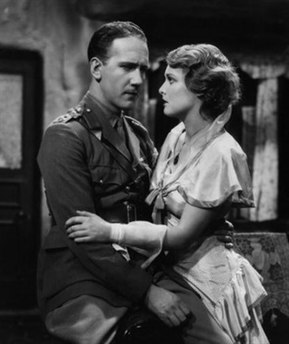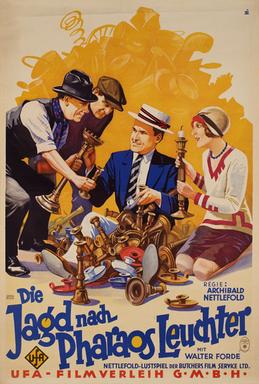Related Research Articles
Frank Stanmore was an English film actor. He appeared in 76 films between 1914 and 1938. He was born in London and died in Gravesend, Kent.

Silver Blaze is a 1937 British, black-and-white crime and mystery film, based loosely on Arthur Conan Doyle's 1892 short story "The Adventure of Silver Blaze". It was directed by Thomas Bentley, and was produced by Twickenham Film Studios Productions. It stars Arthur Wontner as Sherlock Holmes, and Ian Fleming as Dr. Watson. In the United States, the film was released in 1941 by Astor Pictures, where it was also known as Murder at the Baskervilles, retitled by distributors to capitalize on the success of the Basil Rathbone Holmes film, The Hound of the Baskervilles.
The Man Outside is a 1933 British crime film directed by George A. Cooper and starring Henry Kendall, Gillian Lind and Joan Gardner. It was shot at Twickenham Studios in London and features sets designed by the art director James A. Carter. Made as a quota quickie, it was distributed by RKO Pictures. It is unrelated to the play The Man Outside, which was not written until 1946.

French Leave is a 1930 British comedy film directed by Jack Raymond and starring Madeleine Carroll, Sydney Howard and Arthur Chesney. It was made at British and Dominions Elstree Studios. It is based on a play by Reginald Berkeley, a "light comedy in three acts", set during the First World War. It was remade in 1937 by Norman Lee.
Let's Love and Laugh is a 1931 British-German comedy film directed by Richard Eichberg and starring Gene Gerrard, Muriel Angelus and Dennis Wyndham. A German-language version, Die Bräutigamswitwe, was made at the same time. It was based on the play, Unwelcome Wife, written by Edward A. Paulton and Fred Thompson.
Timbuctoo is a 1933 British comedy film, co-directed by Walter Summers and Arthur B. Woods for British International Pictures, and starring Henry Kendall and Margot Grahame. Although BIP had a reputation for churning out films quickly and cheaply, in this case they allocated enough of a budget to finance location filming in Africa.
What a Night! is a 1931 British comedy crime film directed by Monty Banks and starring Leslie Fuller, Molly Lamont and Charles Paton. It was made at Elstree Studios as a quota quickie.
Watch Beverley is a 1932 British comedy film directed by Arthur Maude and starring Henry Kendall, Dorothy Bartlam and Francis X. Bushman. It was adapted from a play by Cyril Campion. It was shot at Shepperton Studios outside London.
The Great Gay Road is a 1931 British drama film directed by Sinclair Hill and starring Stewart Rome, Frank Stanmore and Kate Cutler.

The Flying Fool is a 1931 British comedy thriller film directed by Walter Summers and starring Henry Kendall, Benita Hume and Wallace Geoffrey. It was based on a 1929 play of the same name.
Three Men in a Cart is a 1929 British silent comedy film directed by Arthur Phillips and starring Frank Stanmore, Joan Morgan and David Dunbar. It was made at Isleworth Studios as a quota quickie for distribution by Universal Pictures. Its plot concerns three friends who discover buried treasure.

What Next? is a 1928 British silent comedy film directed by Walter Forde and starring Forde, Pauline Johnson and Frank Stanmore. It was made at Nettlefold Studios in Walton-on-Thames. There is a copy held at the BFI archive.
Red Pearls is a 1930 British silent crime film directed by Walter Forde and starring Lillian Rich, Frank Perfitt and Arthur Pusey. It was made at the Nettlefold Studios in Walton. It was based on the novel Nearer! Nearer! by J. Randolph James. The film was produced just as the change to sound films was taking place in Britain.
The Old Man is a 1931 British mystery film directed by Manning Haynes and starring Maisie Gay, Anne Grey and Lester Matthews. It is based on the play of the same name by Edgar Wallace, with several actors reprising their roles. The film marked the screen debut of Scottish actor Finlay Currie.

Lucky Girl is a 1932 British musical comedy film directed by Gene Gerrard and Frank Miller and starring Gerrard, Molly Lamont and Gus McNaughton. It was made at Elstree Studios with sets designed by the art director John Mead. It was based on a play titled Mr. Abdullah.

That's a Good Girl is a 1933 British comedy film directed by Jack Buchanan and starring Buchanan, Elsie Randolph and Dorothy Hyson. The film was based on a musical show of the same title that opened at the Lewisham Hippodrome on 19 March 1928, in which Jack Buchanan also starred. The music was written by Joseph Meyer and Phil Charig, with lyrics by Douglas Furber. The film omitted much of music of the original show, but popularised one song in particular, Fancy our Meeting. The song remained a Jack Buchanan favourite and a version of it was also recorded by Al Bowlly shortly after the film's release.
Chamber of Horrors is a 1929 British silent horror film directed by Walter Summers and starring Frank Stanmore and Elizabeth Hempel. It was made at Welwyn Studios. Film historians consider this movie the last major silent film made in England.

William Arthur Schröpfer known by the pen name and stage name Arthur Macrae was an English playwright and comic actor. He graduated from RADA in 1928; with acting work including the original West End productions of Noël Coward's Cavalcade (1931), and South Sea Bubble (1956). He wrote the book for the 1945 hit West End musical Under the Counter.
The Christian is a 1915 British silent film directed by George Loane Tucker and starring Derwent Hall Caine and Elizabeth Risdon. The film is an adaptation of Hall Caine's 1897 novel The Christian. This was the third film of the story, the first The Christian (1911) was made in Australia and the second The Christian (1914) was made in the United States. The Christian was made by the London Film company, which was at the time England's most highly regarded producing organisation and whose policy was to film works of the great authors.

The House Opposite is a 1931 mystery crime novel by the British writer Joseph Jefferson Farjeon. It was the second in his series of novels featuring Detective Ben, following the 1926 novel Number 17. It was published by the Collins Crime Club which had been established the previous year.